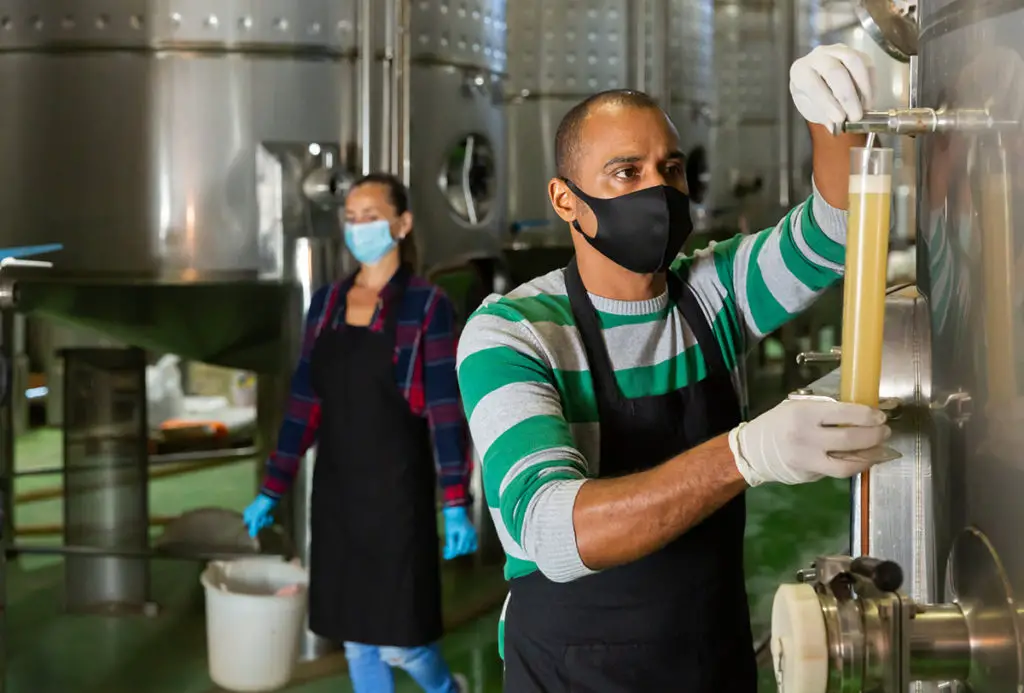Making wine at home can be a great way for wine enthusiasts to procure and enjoy wine. Not only can homemade wine be healthier than bottled or mass-produced wine, but it can also be a better fit for you as you can make adjustments during the wine-making process to suit your specific tastes. One issue, however, that home vintners face is how to tell when their wine is finally done fermenting.
How to tell when wine is done fermenting:
- Identify how long your wine should take to ferment.
- Visually inspect your wine.
- Measure the specific gravity of your wine.
With these three simple steps, you’ll know for sure whether or not your wine is done fermenting. Let’s get into each of them to learn how to tell when your wine is ready to age!
1. Identify How Long Your Wine Should Take To Ferment
Fermentation is when yeast or other organisms break down sugars and convert them into alcohol. As an alcoholic beverage, your wine will need to go through this process to turn your grapes (or other fruit!) into alcohol.
The fermentation process can take anywhere from five days up to three weeks. In general, sweeter wines will take less time to ferment. This is because more and more sugar is consumed through the fermentation process, thus leaving you with a drier wine.
You should have a ballpark of how long the fermentation process will take depending on the type of wine you are making. However, since other factors such as temperature, fruit used, and added sugars can affect the fermentation process, don’t try to pinpoint an exact date when your fermentation process will be complete.

Gold Medal Wine Club - Boutique, award-winning wines delivered monthly! → Choose Your Wines
2. Visually Inspect Your Wine
Once the fermentation process has begun, the very first thing you should look at is your wine’s visual appearance. When fermentation occurs, you’ll see little bubbles fizzing up to the top of your wine, almost like you would in a soda or sparkling water.
If you’re fermenting your wine with an airlock, you’ll see bubbles passing through it if the wine is still fermenting. Best leave your wine alone if there are still plenty of bubbles in the airlock or the wine itself.
Once fermentation has slowed down, the number of bubbles should also reduce drastically. Note that the bubbles likely won’t completely disappear, so it’s important to routinely check your wine to notice a decrease in bubbles.
Another thing you’ll notice when fermentation is slowing down is that your wine will be clearer. As yeast is suspended through the wine during fermentation, the wine will get a cloudy appearance as the yeast is doing its job. Once it’s done, the yeast will fall to the bottom and make the wine easier to see-through.

3. Measure the Specific Gravity of Your Wine
Finally, you should always measure the gravity of your wine to confirm that fermentation is complete. Although visual cues can help give us a good idea of your wine’s fermentation status, nothing beats actual measurements for checking that fermentation is complete.
You can measure your wine’s gravity with either a hydrometer or a refractometer.
Use a Hydrometer To Measure Wines Specific Gravity
A hydrometer is a handy tool that will allow you to measure the sugar content of your wine, its alcohol percentage, and the gravity of your wine. If you’re unfamiliar, with the term “gravity,” it refers to the density of a given liquid in relation to the density of water. So, the higher the gravity, the more dense the liquid will be.
Wine gravity ranges from .990 for drier wines up to 1.005 for sweeter wines. This is because sweeter wines have higher sugar content, thus making the wine denser in relation to water.
Although you might think that there is a magic gravity number that you should strive for, you should actually use your hydrometer to review the rate of change of your gravity. In other words, if the gravity of your wine keeps changing, that means the fermentation process is still ongoing!
If you notice that your wine gravity readings have not changed at all for three days, congrats! The fermentation process is over, and you can start aging your wine.
If you don’t yet have a hydrometer, I recommend this Brewer’s Elite Hydrometer Set from Amazon. Not only is it quite inexpensive, but it includes everything you need to get a thorough reading of your wine as it’s fermenting.
If you haven’t used a hydrometer before and need a demonstration, check out this quick 3-minute YouTube video to learn how to use your hydrometer to check the status of your fermentation:
Use a Refractometer To Measure Wines Specific Gravity
Refractometers can be just as helpful as hydrometers when checking if a wine is done fermenting. Unlike hydrometers, most refractometers will only check for the gravity of the wine. It won’t give you additional info about its alcohol percentage or sugar content.
If you’re only trying to check if fermentation is complete, then knowing the gravity of your wine should be enough.
One of the benefits of using a refractometer instead of a hydrometer is that you only need two or three drops of wine to get an accurate read. This can be helpful if you are making a lot of wine, as it will help you reduce waste.
If you already have a refractometer that you’d like to use, you can follow the same procedure as you would with a hydrometer: check wine gravity at regular intervals and stop fermenting when the gravity stays stable for three consecutive reads.
If you don’t yet have a refractometer, I recommend this Aichose Brix Refractometer from Amazon. This refractometer has the added benefit of giving you a sugar content read in addition to the gravity, so it can be almost as helpful as a hydrometer without all the waste.
Check out the following YouTube video for a quick demonstration on how to use a Brix refractometer:
Key Takeaways
The fermentation process is arguably one of the most important parts of the entire wine-making process. If you’re not sure how to check if the wine is done fermenting, keep the following in mind:
- You should monitor your wine for signs of decreased yeast activity like fewer bubbles and a less cloudy appearance.
- Measure wine gravity at regular intervals and pay attention to when it stops changing.
